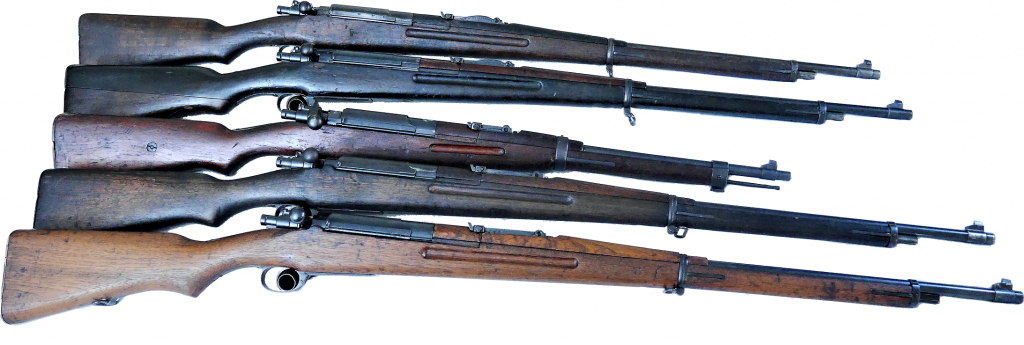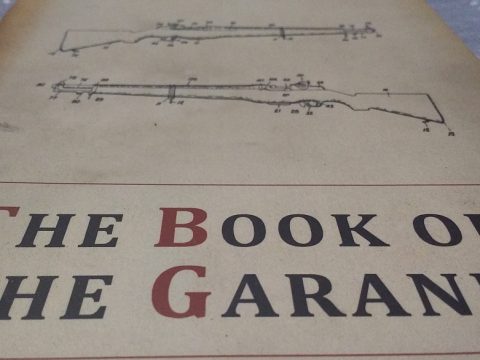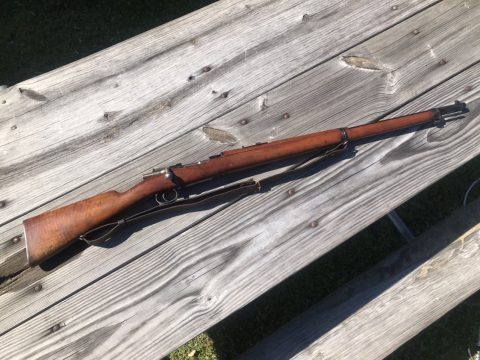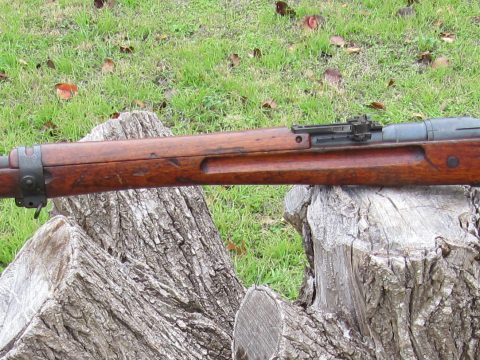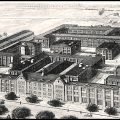This guide will hopefully be able to provide you with a good base of understanding of the basics of the Siamese Mausers. This guide is certainly not all-inclusive and there is likely going to be oddities in Siamese Mauser variants that don’t exactly match up. As Thailand has not produced much in the way of documentation, most of what is currently known about Siamese Mausers comes from the direct observations of collectors. However, since the group dedicated to collecting them is so small, it is relatively easy for rare examples to be completely unknown to the dedicated collectors. If you come across any Siamese or Thai firearm you think maybe an abnormal example please let me know so I can document it and pass that information on to other collectors.
Siam (modern day Thailand, which I’ll refer to interchangeably depending on context) in the 1800’s found itself in some rather unique circumstances. While the European Colonial powers were claiming all the territory in Asia that they could, Siam was left to exist on its own. This wasn’t due to them being inaccessible or being militarily strong enough to resist, but rather a quirk of luck. The British had claimed the territory to the west of the Kingdom of Siam while the French claimed the territory to the east. Both countries, which historically didn’t always get along, mutually decided to leave the Kingdom of Siam to its own autonomy as a buffer zone between their territories. The King of Siam, Chulalongkorn (also known as King Rama V), knew that the existence of his Kingdom was tenuous at best, and reliant completely on the powerful European countries allowing them to be. In order to ensure the Kingdom’s continued existence, he initiated plans to rapidly modernize Siam in hopes of being recognized in the eyes of the European powers as a legitimate modern civilized country with the same standing as any European country. Part of those efforts was a modernization of the military.
In pursuit of modernizing its military, Siam began looking for a modern rifle to equip its infantry. Due to Siam being in a unique position they wound up developing, though not a completely new rifle, a very unique twist on one of the best designs in the world at the time. Despite the uniqueness of their firearms, they are often overlooked by collectors. Thailand didn’t keep the best records on their firearms so a lot of what is known about them is based on observations of examples that have been found on the collector’s market. Unfortunately as a result of lacking easy access to data on Siamese/Thai firearms there has been a lot of outdated (and some downright false) information being passed around about these rifles. If you have ever had an interest in, or are just plain curious about the Siamese Mauser this should give you a pretty good overview of the basics to help you on your way to discovering this unique take on the Mauser.
The Type 45 Rifle

Siam began searching for a new rifle in the early 1900’s. After looking at the various existing Mauser designs, they selected the various features they had liked best in a Mauser rifle as well as including the dust cover design from the Japanese Type 35. While Siam would have liked Mauser to have built the rifle design they came up with, Mauser at the time had its plate full with large contracts for both Germany and Turkey. Looking for an alternative manufacturer, Siam found that the Imperial Japanese Army Tokyo Arsenal was willing to take up the manufacturing of this new rifle. Siam officially adopted this new rifle late in the 121st year of the Rattanakosin Era (early 1903) and thus was designated as the R.S. 121. Siam contracted with the Imperial Japanese Army Tokyo Arsenal for an initial order of 20,000 rifles (serial numbers 1-20,000), and later ordered an additional 20,000 rifles.

In 1913 Siam’s King, Vajiravudh (Rama VI), decided to change the calendar to match that of the Buddhist calendar. Along with the calendar change, the rifle’s designation was updated to match that of what the new year system The year the rifle was originally adopted (under the Buddhist calendar) was 2445 so rifles manufactured under the first contract that were still in their original manufactured configuration were re-designated as Type 45.
The overall appearance of Type 45 Siamese Mauser is that of a pretty typical Mauser with the addition of the Type 35 style sliding dust cover, which must be manually opened prior to use.


On the butt plate there is a sliding door instead of the more typical outward opening door style.

Internally, the box magazine is shaped differently to allow for the use of rimmed cartridges.

The rear sight is a “v” notch with a ramp on the steeper side, the front sight is an unprotected variant, and a typical Mauser-style bayonet lug is mounted to the stock under the barrel.


The serial number is printed using Thai numerals instead of the more common Arabic numerals. Here is a quick chart to aid in translation. If you do not have access to this Chart or others like it, you can simply use the rear sight distance designations to translate by remembering the closest setting is a “2” for two hundred meters
Arabic Numerals
Thai Numerals

The Type 46 Rifle

When Siam contracted the second batch of 20,000 rifles (serial numbers 20,001-40,000) there were some slight changes made to the design.* These changes were made due to the Japanese-sourced wood having an inherent weakness that could lead to the stock splitting. Despite these changes, the rifles were still designated as the R.S. 121 like the previous batch and marked as such. When Siam moved to the new calendar however they decided to apply a new designation to the rifles with these changes to denote that these rifles have differences from the original Type 45 pattern. The designation Type 46 however applies to more than just the rifles from this second contract. As Type 45 rifles were damaged it was common to rebuild them to the newer Type 46 pattern, so they too are designated as Type 46 rifles.
The Type 46 rifles had 4 main differences between them and the Type 45. To deal with the weaker nature of the wood available in Japan, they changed from a stock made from a single piece of wood to one made from two pieces like those found on the Japanese Arisakas.

Along with the two-piece stock, they also added an upper-rear tang off the end of the receiver and a lower tang off of the trigger guard (both of which required a very minor modification of the original design), again very similar to what is found on the Japanese Arisakas.


The third change was to the butt plate design. While the original Type 45 had a top screw that went in at a 45 degree angle, the Type 46’s butt plate was changed so the top screw entered at 90 degrees into the top of the stock (again like the Japanese Arisakas).

The final change between the Type 45 and Type 46 rifles was the base of the front sight blade. On the Type 45’s front sight blade, the blade’s base overhung the front sight base. On the Type 46’s front sight blade, the base of the blade is flush with the sight base.

Things are not always that clear cut however, and you will often find rifles with a mix of both Type 45 and Type 46 features. For example, if a Type 45 rifle had been damaged and they were upgrading it to the Type 46 pattern they would often use the original components (if undamaged) like the buttplate. On top of that, because Siam had native wood that was stronger they could make the stocks out of one piece of wood. This means that Type 45’s that got upgraded to the Type 46 pattern will have had their stocks replaced, with a one-piece stock made from the Siamese wood instead of the usual two-piece made from Japanese wood. Similarly, original Type 46 rifles that had damaged stocks would have had those replaced with one-piece stocks made from the stronger Siamese wood as well.

Due to these components often being mixed between models, the most consistent way of identifying the model is the appearance of whether or not there are upper and lower tangs. Thus, if the rifle has them it’s a Type 46, and if it doesn’t it’s a Type 45.
The Type 47 Carbine
(No Picture of original Type 47 carbine available)
In 1904 Siam contracted with the Imperial Japanese Army Tokyo Arsenal to build 10,000 carbine (serial numbers 1-10,000) versions of the R.S. 121. Due to Thai not having a native word for carbine at the time, these rifles were classified as short rifles and designated as the R.S. 123. Note the seeming two year difference between R.S. 121 and R.S. 123 even though they were manufactured in 1903 and 1904, respectively. This is a result of the original Siamese calendar starting in April instead of January like the modern Gregorian calendar. When Siam moved to the new Buddhist calendar these rifles were re-designated as the Type 47 in conjunction with the year they were adopted, 2447. These carbines share most of the same features of the Type 46 rifles, though with a shorter 20.25” barrel. Other noticeable differences include the magazine floor plate release button being moved from the trigger guard to just in front of the floor plate,

the absence of a bayonet lug, and a rear sight zero of 300 meters instead of 200 meters. As of the date this was written, it is believed that very few (if any) Type 47’s survived in their original configuration. It is believed that nearly all of them received additional upgrades (detailed below) while in service.
The Type 45 Cartridge

Along with a new rifle Siam adopted, it also adopted a new cartridge. This new cartridge, like the rifle, was also originally designated as the R.S. 121. This later was redesignated as the Type 45 after Siam moved to the new calendar like the Type 45 Rifle. This cartridge is an 8x50mm rimmed round with an approximately 239 gr. bullet that fired with a velocity of approximately 2050 fps.

The Type 66 Cartridge

In 1923 (Buddhist calendar year 2466) Siam decided to modernize the cartridges they were using. Not wanting to completely replace all the firearms in the military inventory, it was decided to make only slight changes to the basic 8x50mm cartridge so the existing firearms could relatively easily be modified to fire the new cartridge. What they came up with was an 8x52mm rimmed cartridge by adding .02” in length before necking down and fired a 180 gr. Spitzer bullet at an approximate velocity of 2250 fps.

The Type 47/66 Carbine

With the introduction of a newer cartridge, Siam began modifying the Type 47 rifles for use with the new cartridge. This involved two main changes: reaming out the chamber slightly so the new cartridge could be chambered and grinding down the rear sight ramp to match the ballistic trajectory of the new round.

The new designation for the rifle became the Type 47/66, and (as mentioned previously) it is believed pretty much all Type 47’s received the upgrade, due to the fact that so far no single original configuration Type 47 has been found by the collector community. The Type 47/66 also have an additional change from original Type 47’s: they have been modified to take a Japanese Type 30 style bayonet as Siam found themselves often issuing these rifles to more troops than just cavalry like originally intended. It is currently unknown whether this change was made before, during, or after the Type 47/66 upgrade.

In addition to the original contract of Type 47’s that received the upgrade, in the mid to late 1930’s Siam manufactured an approximate additional 3000 Type 47/66 (serial numbers ~10,000-~13,000) in the Bangkok arsenal using the original tooling they had received from the Imperial Japanese Army Tokyo Arsenal. These were brand new manufactured and not made by simply cutting down existing Type 45/Type 46’s

It has been noted that there are a few “Type 47/66’s” that seem to have been made from cut down Type 45’s and Type 46’s, but as of now there is no evidence that these were made by Siam and it is believed they were gunsmith projects after having been imported.
The Type 45/66 Rifle

Like with the Type 47/66, Siam also began upgrading the rest of their stock pile of rifles for the new cartridge. Within that stockpile were Type 45’s that had not been upgraded to the Type 46 pattern. If the rifles didn’t have any outstanding issues they were left in the Type 45 configuration and just upgraded to take the new cartridge.

These rifles are often referred to with the designation of Type 45/66 by collectors. The reason for noting that the Type 45/66 is specifically a designation used by collectors is that currently there is no solid evidence that Siam’s military having used a unique designation for this configuration. Collectors find this designation useful as it conveys what variation it is, and it aligns with the designation of Type 47/66 (which was a designation that was definitely used by the Siamese military). Like the Type 47/66, this process involved reaming out the chamber slightly and grinding down the rear sight ramp to match the trajectory of the new cartridge. This modification is easy to spot as originally there were distance markings on the side of the ramp, and those markings were half cut off during the process.

The Type 46/66 Rifle

Just like the Type 45’s, Type 46’s were also upgraded to the new cartridge. These rifles are referred to by collectors as Type 46/66’s, and like with the Type 45/66 this is a collectors’ designation that is not known to have been used by the Siamese military.

Again, like the Type 45/66’s the modification of Type 46’s to Type 46/66’s involved reaming out the chamber slightly and grinding down the rear sight ramp. This modification can also easily be spotted by the markings on the side of the ramp being half ground off like on the Type 45/66’s.

The Type 66 Rifle

As an additional note, the designation Type 66 is not a correct designation for any of the Siamese Mauser variants and is rather an Arisaka based rifle, which is outside the scope of this article.
_________________________
* Typical of contracts such as this the supplier often assembles slightly more rifles than called for as it uses up all of the parts manufactured to construct the rifles. Thus, the high serial number reported for Siamese Mausers is 40155)
*New* In 1913 there was military manual called the “King Rama V Gun Handbook” or at least that is a rough translation of the title. I recently given a series of pictures of every single page in that book which I enhanced the best I could and used to create a PDF version of the book. It’s doesn’t look professional, nor are the pictures perfect, but I do believe it is for the most part functional if you can read Thai so I’ll share it here. I am going to go through and attempt to make a rough translation of it but I don’t speak or read Thai so I am stuck using an OCR program and google translate. If I can manage to get something somewhat useful I will share that translation as well. If not then I am sorry but only people that can read Thai will be able to read it unless one of them is willing to translate it. Here is the link to the King Rama V Gun Handbook PDF https://drive.google.com/file/d/1BLYYeSVxL2lx4BZkwPCTQk2WhqItmGBx/view?usp=sharing
Thanks to Francis C. Allan who provided the pictures of the cartridge, Type 66 rifle, and the Tokyo Arsenal made Type 47/66 and it’s rear sight for this article from his book The Siamese Mauser. Francis C. Allan also reviewed this article to ensure accuracy.

